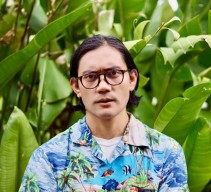John Kenneth Paranada

John Ellerman Foundation Curator of Art and Climate Change at the Sainsbury Centre, University of East Anglia and researcher at the Tyndall Centre for Climate Change Research
John Kenneth Paranada is the John Ellerman Foundation Curator of Art and Climate Change at the Sainsbury Centre, University of East Anglia and researcher at the Tyndall Centre for Climate Change Research. His interdisciplinary curatorial practice focuses on experimental futures and hybrid forms, focusing on climate change, sustainability, historical entanglements, the Anthropocene period and new media technologies.
Recent publications include: Collisions: Art & Climate Change (Museum of Design and Contemporary Art Manila, 2023), How Do We Begin A Meaningful Conversation About Art's Place In the Climate Crisis (Sainsbury Centre, 2023), All Is Not Forgiven: 50th Year Anniversary of the Cultural Centre of the Philippines, (CCP, 2020), Inclemencies of the Tropical Sun: Cian Dayrit, *(Frieze Art Fair London, 2019) Ecologies & Cosmologies, (*the National University of Singapore Museum, 2019)
Prior to his tenure at Sainsbury Centre, Ken held curatorial positions at the New Museum of Contemporary Art, the Cultural Centre of the Philippines, the Shanghai Biennale, the London Design Biennale and many other globally renowned institutions.
Ken received his Master of Fine Arts in Curating with a focus on art in the Anthropocene at Goldsmiths College, University of London (2016) and Master of Advanced Studies in Curating with a focus on Social Sculpture at the Zurich University of the Arts, Switzerland (2015). He studied Philosophy of Nature under Bruno Latour at Science Politique Paris, funded by the Institut Francais (2013). He attended the Master of Arts in Museum Studies at the University of the Philippines Diliman ( 2009) and a Bachelor of Arts in Philippine Studies at De Lasalle University - Manila (2005).
Recent publications include: Collisions: Art & Climate Change (Museum of Design and Contemporary Art Manila, 2023), How Do We Begin A Meaningful Conversation About Art's Place In the Climate Crisis (Sainsbury Centre, 2023), All Is Not Forgiven: 50th Year Anniversary of the Cultural Centre of the Philippines, (CCP, 2020), Inclemencies of the Tropical Sun: Cian Dayrit, *(Frieze Art Fair London, 2019) Ecologies & Cosmologies, (*the National University of Singapore Museum, 2019)
Prior to his tenure at Sainsbury Centre, Ken held curatorial positions at the New Museum of Contemporary Art, the Cultural Centre of the Philippines, the Shanghai Biennale, the London Design Biennale and many other globally renowned institutions.
Ken received his Master of Fine Arts in Curating with a focus on art in the Anthropocene at Goldsmiths College, University of London (2016) and Master of Advanced Studies in Curating with a focus on Social Sculpture at the Zurich University of the Arts, Switzerland (2015). He studied Philosophy of Nature under Bruno Latour at Science Politique Paris, funded by the Institut Francais (2013). He attended the Master of Arts in Museum Studies at the University of the Philippines Diliman ( 2009) and a Bachelor of Arts in Philippine Studies at De Lasalle University - Manila (2005).
Sediment Spirit: Towards the Activation of Art in the Anthropocene
Over the past years, the relationship between art, ecologies and the environment has become more and more vital as artists across the globe use their work to raise awareness and initiate change. For as long as humans have existed, artists have raised questions about our relationship with the natural world. Anthropologists and art historians point us as far back as the animal paintings in the cave of Lascaux, France, in palaeolithic times- 64,000 years ago. Visual art has always been an interface of new visual languages, producing new explanations and pathways. Artists can reframe complex climate change science into urgent works that engage audiences and remind them of their own complicity and a better path to a more sustainable future. This lightning presentation will lay out the rationale of the art exhibition Sediment Spirit: Towards the Activation of Art in the Anthropocene at the Sainsbury Centre, University of East Anglia, the philosophical inspiration and the arguments for the creation of a new exhibition in response to the climate crisis, one that examines the ways in which art and material culture can play a vital role in interrogating the social and scientific impacts of the climate crisis and inspire action and change to a more sustainable future.
